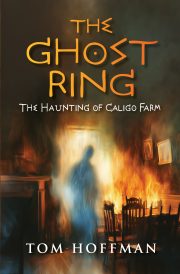Guest Post: Who Controls Your Amazon E-book Price?
by Jim C. Hines

As most of you know, I’ve self-published a few e-books. The most popular has been Goblin Tales [Amazon | B&N], a collection of five goblin-related short stories. I priced it at $2.99, which seemed fair, and means I receive Amazon’s 70% royalty rate, earning roughly $2/copy sold.
From a strategic standpoint, Amazon’s decision to offer 70% royalties to self-published authors was brilliant. A lot of authors who might not have otherwise self-published started putting both backlist and new titles up for sale. Over the course of several years, Amazon has become (in my opinion) the major player in self-publishing and e-books.
A certain champion of self-publishing recently decried all of the “whiny bitches” complaining about Amazon, and argued how Amazon treats authors so much better than commercial publishers.
While there are certainly advantages to Amazon’s program, anyone who thinks Amazon is in this to help authors is a fool. Amazon, like pretty much any other business, is in this to make money. As for how they treat authors, let me share what I’ve experienced over the past week and a half.
Amazon can and will adjust your price as they see fit.
On Saturday (2/11), I noticed that Amazon had marked Goblin Tales down to $.99. I don’t know why, and I don’t know when exactly this change was made.
This wasn’t the first time I’d had trouble controlling the price of my own e-book. I put Goblin Tales on sale over the holidays, then returned it to $2.99 in early January. Rather, I tried to do so. Only Kobo was slow to raise their price, and since Amazon’s Terms of Service allow them to match any competing price, Goblin Tales stayed at $.99 with its reduced royalty rate for several more weeks, earning me about 1/6 of what I normally made for each sale (35% royalties based on the $.99 price-matched price).
So when I saw that Amazon had dropped the price again, my first step was to check other listings. Everywhere else, the book was on sale for its list price of $2.99. I saw no external reason for Amazon to drop the price.
I also heard from another author that several of their books had also been cut to $.99 without warning or explanation, making me suspect this was either a database glitch or an arbitrary price cut.
I’ll give Amazon credit – the Kindle Direct Publishing (KDP) team responded to me fairly quickly, and restored the price to $2.99 by Valentine’s Day. But they also pointed to section 5.3.2 of the current Amazon/KDP Terms and Conditions, which gives them:
…sole and complete discretion to set the retail price at which your Digital Books are sold through the Program.
So what’s the big deal? Don’t retailers put things on sale all the time? Well, sure … which leads me to my second lesson.
Amazon can calculate royalties based on the sale price, not your list price.
With my DAW books, if a bookstore offers a sale, I still get my royalties based on the cover price. Amazon is selling Libriomancer for pre-order at almost half-off, but I’ll get paid my full amount for every copy sold. Not so with self-published titles. Looking at my reports for last week, my royalties were slashed by 2/3 for every copy sold, because Amazon paid me 70% of the $.99 sale price, not my list price.
According to the KDP Pricing Page, royalties should be based on the list price ($2.99) unless the price adjustment was due to a price-matching situation (dropping the price to match a competitor’s price) … but my royalties report still shows a 67% cut.
When I followed up with the DTP team, they responded thusly:
The price at which we sell your book may not be the same as your list price. This may occur, for example, if we sell your book at a lower price to match a third party’s price for a digital or physical edition of the book… In this case, if you have chosen the 70% option for your book, your 70% royalty will be calculated based on our price for the book (less delivery costs and taxes).
Of course, this wasn’t actually the case, as there was no lower third-party price. I asked them again to show me where their Pricing Page or Terms of Service allow Amazon to arbitrarily cut your book’s offer price and reduce your royalties based on that change. I haven’t heard back from them.
Sometimes going it alone sucks.
If a retailer pulled a stunt like this with one of my commercially published books, DAW/Penguin would stomp them. If DAW tried something funny in my royalty statements, my agent would be all over that crap. Given that my agent represents a number of authors, including folks like Brandon Sanderson, Charlaine Harris, Tanya Huff, etc., he’s got some pull.
But self-publishing puts you in charge of every aspect of your career. Meaning when Amazon messed with one of my books, it was on me to challenge them and get it fixed. They did restore the price, as I said, but what exactly would I do if they said “Deal with it.” Sue them? That’s theoretically an option, sure … but I still remember how much it cost, in time and money and energy, the last time I had to fight a court battle.
I’ve now sent four e-mails to their KDP team, and they have yet to get back to me with a straight answer as to why or how this happened. At this point, I figure getting the price restored is probably the best I’m going to get.
Diversification is a good thing.
Fortunately, in the end, this incident had little real impact on my finances. Goblin Tales sold sixteen copies at the reduced rate, meaning I was underpaid by a whopping $21 or so. Barely even worth a blog post, right? But the impact was minimal because:
- Most of my titles are not self-published, so if Amazon messes with those titles, the bulk of my income stream is unaffected.
- I discovered the problem fairly quickly and took steps to get it fixed.
I certainly intend to keep my e-book collections up on Amazon. I’m even planning to publish another one. I’m not telling people not to publish through Amazon; I am telling you to go in with your eyes open, and to understand that despite what the cheerleaders might suggest, Amazon is not pro-author. They’re pro-Amazon.
One final note.
According to Section 2 of their Terms and Conditions, Amazon “reserve[s] the right to change the terms of this Agreement at any time in our sole discretion.” On February 9 — just two days before the Goblin Tales glitch — they added the following:
KDP RELIES ON COMPLEX SYSTEMS AND PROCESSES. WE STRIVE TO MAKE OUR SYSTEMS AND PROCESSES ERROR-FREE AND EFFICIENT, BUT WE CANNOT GUARANTEE THAT THEY WILL BE, AND WE WILL HAVE NO LIABILITY ARISING FROM SYSTEM OR PROCESS FAILURES, INTERRUPTIONS, INACCURACIES, ERRORS OR LATENCIES.
Bottom line? They make the rules, they can change the rules whenever they feel like it, and they aren’t liable when they break the rules.
Editor’s Note: Jim C. Hines has posted more information in an update on his website.
•••
 Jim C. Hines’ next book is Libriomancer, a modern-day fantasy about a magic-wielding librarian, a hamadryad, a secret society founded by Johannes Gutenberg, a flaming spider, and an enchanted convertible. He’s also the author of the Princess series of fairy tale retellings as well as the humorous Goblin Quest trilogy. His short fiction has appeared in more than 40 magazines and anthologies. Online, he can be found at http://www.jimchines.com, where this post first appeared.
Jim C. Hines’ next book is Libriomancer, a modern-day fantasy about a magic-wielding librarian, a hamadryad, a secret society founded by Johannes Gutenberg, a flaming spider, and an enchanted convertible. He’s also the author of the Princess series of fairy tale retellings as well as the humorous Goblin Quest trilogy. His short fiction has appeared in more than 40 magazines and anthologies. Online, he can be found at http://www.jimchines.com, where this post first appeared.


